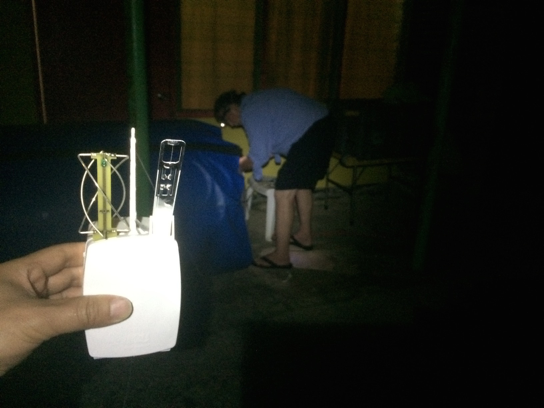Getting used to launching in the rainFebruary 12, 2016by Xiao-Wei Quan (CIRES)
 The surface meteorology station at the radiosonde launching site is used to calibrate the radiosonde sensors. In addition to the sounding variables, it also records rainfall amount in one-minute time intervals. (Credit: Xiao-Wei Quan, CIRES)
The surface meteorology station at the radiosonde launching site is used to calibrate the radiosonde sensors. In addition to the sounding variables, it also records rainfall amount in one-minute time intervals. (Credit: Xiao-Wei Quan, CIRES)
Getting used to launching in the rain
February 12, 2016by Xiao-Wei Quan (CIRES)
KIRITIMATI ISLAND, Kiribati — It’s the afternoon of the 3rd day since I landed on the island. So far, I’ve experienced six radiosonde launchings — three at night (at about 1:00 am local time) and three during the day (at about 1:00 pm). Yesterday and today’s daytime launches were in heavy rain. We must launch the radiosonde by the scheduled time no matter how much it rains. As the island is in its rainy season, and the strong El Niño also brings more rains into the islands — we’re right in the middle of the tropical Pacific Ocean — we need to be prepared to do more launches. Fortunately, Paul is pretty skillful in predicting (or now-casting), with his intuitive observation of changes in local clouds, wind, and temperature, about 5–10 minutes ahead of a coming rain. We managed to avoid one heavy rain when he was showing me around the village on my first day here.
Briefly, a launch involves 5 steps: (1) Prepare the sensor (calibrating it with the surface meteorology station at the launching spot); (2) Fill the balloon with helium gas; (3) Attach the sensor (radiosonde box) to the balloon and launch it; (4) Collect/monitor the data (time, longitude, latitude, height, pressure, temperature, humidity, wind speed and direction) sent back from the sensor; and (5) Pack the data and send it back to our base at Boulder. It takes about 30–60 minutes to launch the balloon (steps 1–3), and 2½ to 3 (or more) hours to complete all the steps.
The rain has continued for about two days with some pauses of couple of hours or so. Sometimes the water poured down at a rate which must have been well above one inch per hour! But by tonight’s launch, the sky was all clear and the stars were twinkling in all directions.
 Preparing to launch a radiosonde. (Credit: Xiao-Wei Quan, CIRES)
Preparing to launch a radiosonde. (Credit: Xiao-Wei Quan, CIRES)
After we filled up the balloon and calibrated the sensors, I held the radiosonde exposed to wind while Paul is attached its string to the balloon (in the blue bag). The metal piece on the right-hand side has the temperature and humidity sensors, the structured antenna on the left-side is for the GPS position. The white stick in the middle holds the string for attaching to the balloon. A battery box is attached to the sensor to supply power for sending soundin signals back.
 Paul monitors sounding data. (Credit: Xiao-Wei Quan, CIRES)
Paul monitors sounding data. (Credit: Xiao-Wei Quan, CIRES)
In the photo at left, Paul monitors the sounding data. The indoor part of the sounding system includes the computer monitor communicates to the surface met station and radiosonde receiver (the gray box behind the computer), the ground check unit (the white box on the desk), and a UPS power supply (the black box on ground), because electric power sometimes goes off during the sounding.
